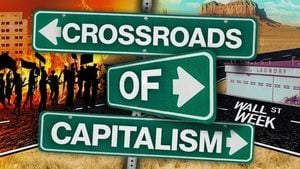As Europe’s central bankers weigh their next move and the U.S. government edges toward reopening, global financial markets are holding their collective breath. Investors, economists, and policymakers are parsing every data point, central bank statement, and political maneuver, trying to divine what comes next for interest rates, currencies, and the world’s largest economies. With the European Central Bank (ECB) signaling the end of its aggressive tightening cycle and the Federal Reserve hinting at patience, the stage is set for a potentially dramatic shift in global bond and currency markets as 2025 draws to a close.
In Europe, the debate has reached a fever pitch. According to Bloomberg, Dan Bulega of ExodusPoint, a major hedge fund managing over $13 billion in assets, is betting that the ECB will cut rates twice in 2025—once in March and again by June. This view is rooted in a simple but powerful observation: eurozone inflation has fallen sharply, hitting 2.5% by October 2025, while economic growth has nearly stalled, with GDP expanding by a meager 0.3%. Bulega believes the ECB’s main refinancing rate, currently at 3.75%, is unsustainable in such an environment. "Policy is too tight for the data," he argues, warning that the central bank risks doing “too little, too late.”
Markets, ever wary, are currently pricing in just one rate cut for next year. But ExodusPoint’s call for two cuts is seen as a bold wager that the ECB will move faster to support growth. The rationale is clear: with inflation largely tamed and consumer demand weakening, there’s room for monetary easing. The last rate cut, in June 2025, brought the refinancing rate to 2.15% and the deposit facility to 2.00%. Since then, the ECB has kept rates steady, adopting a cautious, data-driven approach as inflation stabilizes and growth remains modest.
The impact of these expectations has already rippled through bond markets. German Bund yields—a benchmark for European debt—have dropped from 2.9% in August to 2.45% by November 2025. Italian 10-year bond yields have slipped below 4%, their lowest since early summer. These moves suggest investors are positioning for a return to easier monetary policy, with Bulega dubbing it “the return of duration.” Long-term bonds, once shunned for their volatility, are now back in favor. ExodusPoint, for its part, is increasing its exposure to European government securities, betting that fixed income will lead the recovery trade in 2025.
Not everyone is convinced, of course. Some analysts warn that wage growth could keep inflation sticky, forcing the ECB to hold off until late 2025. Recent Reuters polls show nearly three-quarters of economists expect no further cuts this year, with some predicting rates will remain unchanged through 2026. But even the skeptics agree that the next move is likely down, not up. As Bulega puts it, “When the data turns, policy follows.”
For Europe’s high-debt economies—think Italy, Spain, and France—the stakes are high. Lower rates would ease the burden of servicing massive borrowing accumulated during the pandemic and the energy crisis. The euro, trading around $1.08 in November 2025, reflects the uncertainty: a faster ECB pivot could weaken the currency, boosting exports and giving manufacturers in Germany and elsewhere a much-needed lift.
Meanwhile, across the Atlantic, the U.S. dollar is holding steady, with the dollar index (DXY) rising by 0.06% on November 13, 2025, according to Barchart. The modest gains follow hawkish remarks from Atlanta Federal Reserve President Raphael Bostic, who stated, “Despite shifts in the labor market, the clearer and urgent risk is still price stability.” Bostic favors keeping rates steady until the Fed is confident it’s on track to reach its 2% inflation target. Markets are currently discounting a 64% chance of a 25 basis point rate cut at the December 9-10, 2025 Federal Open Market Committee meeting—a sign that investors see some risk of further easing if economic data deteriorates.
Political drama in Washington has also played a role. The U.S. government shutdown, which had threatened to drag on, appeared close to resolution as the Senate passed a temporary continuing resolution by a 60-40 vote on November 11, 2025. The House was expected to follow suit, and President Trump had said he would sign the measure into law. The reopening of the government would allow the release of delayed economic reports, which may reveal a weakening U.S. economy and add pressure on the Fed to cut rates.
Currency markets have responded with typical volatility. The Japanese yen, for instance, tumbled to a 9.25-month low against the dollar amid concerns that Prime Minister Takaichi will pursue a more expansionary fiscal policy, having indicated plans to drop an annual budget-balancing goal. Japanese Finance Minister Katayama signaled possible intervention to support the yen, decrying “one-sided, rapid currency moves.” Meanwhile, markets are pricing in a 41% chance of a Bank of Japan rate hike at its December 19, 2025 policy meeting. On the data front, Japan’s October machine tool orders surged 16.8% year-over-year, the biggest jump in more than three years—a bright spot in an otherwise uncertain landscape.
Precious metals, too, have felt the tremors. December COMEX gold closed up 2.36%, and silver jumped 5.35% on November 13, 2025, as speculation swirled that the end of the U.S. government shutdown would unleash economic data pointing to further Fed rate cuts. Safe-haven demand for gold and silver remains strong, fueled by ongoing U.S. political uncertainty, tariff concerns, geopolitical risks, and robust central bank buying—China’s central bank, for example, increased its bullion reserves for the twelfth straight month in October. Still, some of the safe-haven demand has been tempered by strength in equities and hopes for political resolution.
The interplay between central bank policy, political developments, and market sentiment is shaping a new reality for investors. In Europe, the prospect of two ECB rate cuts in 2025 could spark a rally in sovereign debt, with strategists estimating each 25-basis-point cut could add 1–2% in capital gains on 10-year bonds. For global investors, this means EU debt—long overlooked—might become one of the hottest plays in a world where yields are finally poised to fall again. As Bulega notes, “The setup looks favorable. Inflation is cooling, growth is soft, and policy will eventually follow the data.”
Risks, however, are never far from view. Energy shocks, fiscal debates, and looming elections could inject fresh volatility into European debt markets. In the U.S., the possibility of renewed political gridlock or economic weakness could force the Fed’s hand. And in Japan, currency intervention and policy shifts remain wild cards.
As 2026 approaches, the world’s major economies find themselves at a crossroads. For now, the consensus—however fragile—is that rates will go lower before they go higher. For investors, that could mean opportunity in places few expected just a year ago. The coming months will test the resolve of central bankers and the nerves of markets alike, as the global economy navigates a new era of uncertainty and change.




